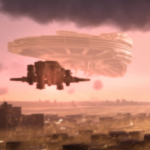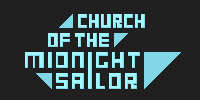Interview: Megaton Rainfall’s Alfonso del Cerro
Megaton Rainfall goes big as a game granting gamers the physical powers of a god fighting an extraterrestrial menace. Where games often trap players in human-scale puzzles and stratagems, developer Alfonso del Cerro has something grander in mind, given the ability to scorch cities with a wrong move, and we chatted on the finer points of his project.
Erik Meyer: Megaton Rainfall places players in the role of an overpowered superhero working feverishly to thwart an alien invasion; as you’ve worked to hone the experience (flying at supersonic speeds, punching through buildings, firing energy blasts), what has given the game the right play feel? What has combined to provide the experience, given godlike power, with a feeling of difficulty?
Alfonso del Cerro: Most of the sense of difficulty comes from the core mechanic of protecting the cities. In this game, you are 100% indestructible, but the cities have health bars, and every time the aliens or your failed shots do collateral damage, the health bar goes down. If it empties, game over. You always have this thrilling pressure to destroy the alien ships as soon as possible and not miss any targets, while not wasting your more advanced and limited superpowers. So the game feels rather difficult, like in any cool action game. And that’s despite the fact that, with your supersonic speed and your skyscraper-shatterer energy blasts, the game will make you feel more powerful than any other game you have ever played (yes, players are saying this after they play our game).
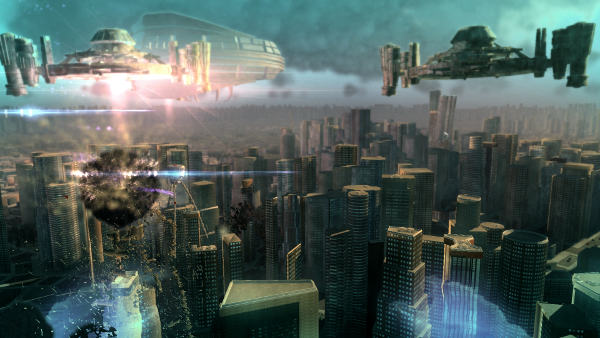
EM: The game has a VR version, so what design challenges have come with that aspect of development? Given the high levels of movement and destruction, do you see console versus VR as dramatically different, or does VR simply bring players closer to the action?
AC: Honestly, when I started working in this game back in 2012, I had no VR in mind. So for me, VR has always been a tool to maximize the sense of scale and immersion in the game but is by no means necessary to enjoy the experience. The freedom of movement across an entire procedurally-generated planet at supersonic speeds is very unique, even if you play on your TV. Having said that, I admit that most people like the VR version more, and it indeed required immense effort to get it working properly. The most difficult VR-related tasks were A) to tune the VR controls to prevent motion sickness while keeping all the freedom of movement (with snapped rotations, different accelerations, blinders, and even modified enemies, AI) and B) to optimize the game so that it preserves the 60 fps at all times (Sony forces this to pass QA). Given the scope of the game, it’s been a huge amount of work for such a small team. Other devs are saying that making a VR-compatible game is like making 2 games at once, and we agree with them.
EM: From an assets standpoint, buildings have to be destructible, alien spaceships have to have a right look-feel, and cities need to feel alive, so in terms of the art direction required to make a metropolitan invasion feel real, what has served as a guide? In designing the planet, what larger strategies have become key?
AC: Our main visual references are Hollywood movies: Man of Steel, Transformers, Pacific Rim… any action movie with collapsed buildings and big explosions. Early on, we realized that to get the proper sense of scale, we needed to render lots and lots of small details. You are always fighting alien drones in front of a background of thousands of buildings, pedestrians, vehicles, trees. We have bet on a style of larger amounts of less-detailed stuff on screen. We’re proud of the result, because the game not only plays differently, but it looks different than any other game thanks to all that. About the planet, it’s the Earth, recreated procedurally and as big as the real thing. Rendering the terrain has proven to be another challenging task. We solved it by combining a height field that we got from NASA, with several layers of fractal noise. And then lots and lots of optimizations.
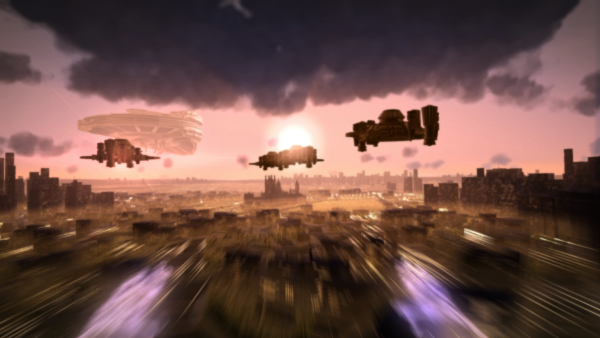
EM: Collateral damage provides an interesting twist, because the player character can’t die, but everything caught in the crossfire can be reduced to ash. How do you see this changing the game, on an emotional level, given that the player becomes a steward attempting to save civilization, as opposed to an experience in which player death provides a caution?
AC: If I have to summarize in one sentence what emotion the game conveys, it’s, “humans are ants”. You get a sense of empowerment and you see that every minimal inaccuracy has massive and terrible consequences, but you feel immune and disconnected to them, watching the destruction from above the ground. All the gameplay mechanics, the visual effects, the sense of ubiquity that you get, are based on this idea that the humans are minuscule and defenseless. Even the ability to fly to outer space and get out of the solar system, showing how insignificant our planet is, adds to that feeling. So it’s not your typical cliché superhero from the movies who has human emotions and relates to people and cares about them. It’s a more interesting and unique approach. I think.
EM: I see the influences of books like The War of the Worlds, in combination with a Superman-esque first-person experience. What other influences might you add as inspiration, and as you’ve implemented game mechanics, what do you see going on in Megaton Rainfall that will surprise people expecting that sort of narrative?
AC: The game takes ideas from a lot of Hollywood blockbusters. A lot of the alien attacks will remind you of movies like War of the Worlds, Independence Day, etc. And I think that helps the game to be more accessible and easily enjoyable, given its extreme uniqueness. Both the gameplay mechanics and the story will fulfill the expectations of gamers like me, eager for fresh and polished experiences. Later in the game, the narrative touches on the issue of the reason for the existence of our universe, which is far from the common ground of superhero movies, games, and even sci-fi. And so far, the reviews we’ve received agree on the novelty of our concept.
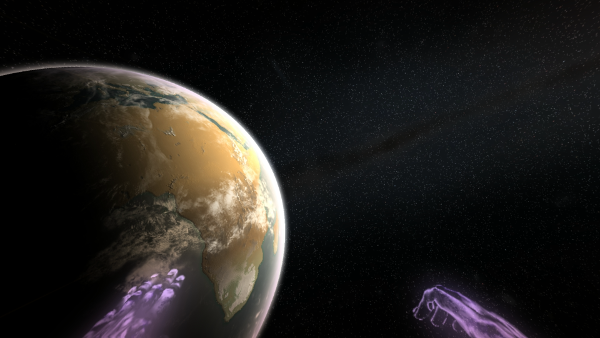
EM: You’ve been developing the game for five years, a studio composed of one dedicated developer, so how do you see this effecting the game, from an overall standpoint? Where have you had to spend most of your energy, and as you check tasks off your to-do list, what has your day-to-day looked like?
AC: My day-to-day life is not very exciting! Most of my energy is spent testing the game, fixing bugs, polishing details, more testing, fixing, polishing, testing… But yes, the “more time, less people” approach to game development gives different results. As I have had no core team or supervisors monitoring the market suitability or the sanity of the project, I’ve been able to spend more time working in the stuff that I really love (procedural destruction, engine optimization, outer space, etc). But you know what? Those things are exactly the elements that people love most about the game. Having said that, thanks to our exclusivity deal with Sony, we were able to hire several artists, including a great musician (David García from Hellblade, Rime), and they all helped the game to look bigger and less indie.
EM: Your project has drawn a lot of attention from the game industry, and you’ve won a number of awards leading up to release, so speak to that process. How have you managed social media, press releases, and the overall process of informing the public? As Megaton Rainfall has developed, how has the project changed, and what kinds of responses have helped shape that change?
AC: Honestly, I consider myself the worst community manager ever. I’m old-fashioned. I don’t use Facebook or Twitter in my personal life. My idea has always been to create content good enough that it sells itself. Not only the game, but the trailers. I do love game trailers. So all the awards, selections, and press mentions that we get come from a scarce few trailers and demos, but each one comes densely packed with never-seen-before content. Of course, we have taken a lot of feedback from all the events where we showcased early versions of our game. But in the end, the attention that we got didn’t come from our social media efforts. Now that the game has been live for 3 weeks, and I can tell you that the numbers of units sold and trailer views easily surpass the number of our followers.
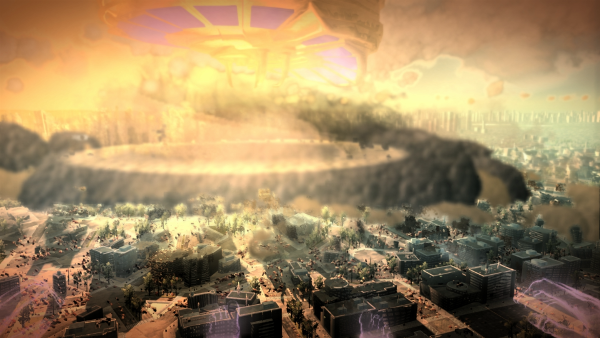
EM: Now that the game has released, what does support look like, and what do you see on the horizon? Namely, how is your pipeline changing? Do you have other projects sparking curiosity in the back of your mind?
AC: I’d like to say that the weeks after the PS4 launch have been relaxing, but there is so much to do: fixing some previously undetected bugs in the game, dealing with the press, and doing interviews (like this one). Also, finishing all the details for our PC launch: the game will come to Steam and Gog on November 17th. Also, in the following months, we’ll port the game to more unannounced platforms. So Megaton Rainfall will be in our lives for some time to come.
In case you missed it, here’s the trailer:

